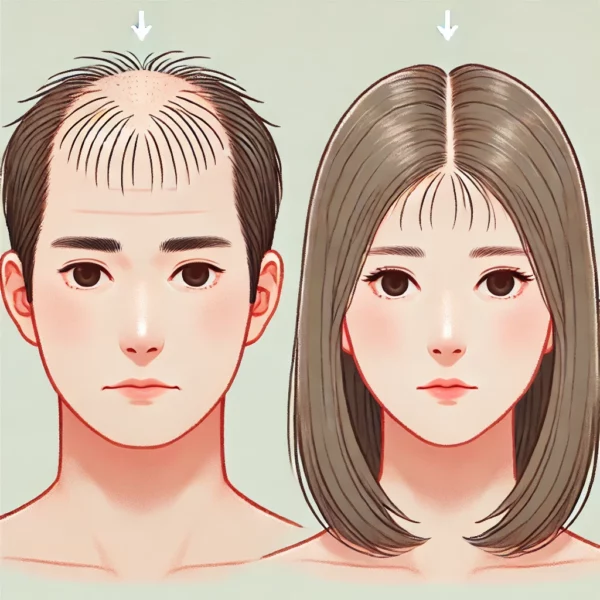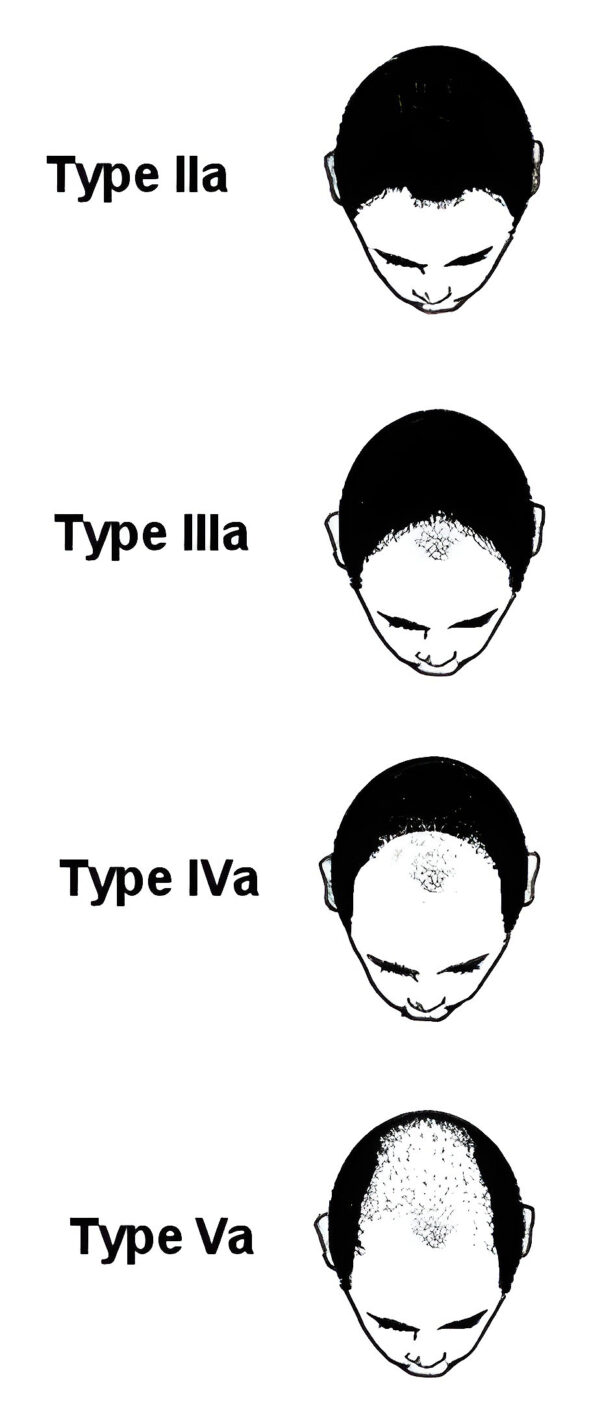Introduction: Androgenetic alopecia (AGA), commonly known as male or female pattern hair loss, is the most prevalent form of hair loss in adults. It affects both genders, though the patterns and prevalence differ. Characterized by progressive thinning of the hair, AGA has a significant genetic and hormonal basis. Recent discussions in both clinical and public health spheres have raised questions about whether the incidence of AGA is increasing in the general population. This article explores the evidence, potential contributing factors, and implications of a potential rise in AGA cases.
Evidence for Increasing Incidence: The evidence for an increasing incidence of AGA is primarily anecdotal and observational. There are limited robust epidemiological studies to confirm the claimed trend. Some dermatologists report seeing more patients with AGA presenting at their clinics in recent years, particularly in South Korea, China, and Japan. However, this could simply be attributed to increased awareness of AGA, better knowledge of potential treatments among the general population, and better diagnostic practices from dermatologists, rather than a true increase in prevalence.
A very few studies have indicated an increasing trend of androgenetic alopecia in specific populations. For example, a small study from Turkey noted a higher prevalence of hair loss compared to previous data, suggesting a possible increase in androgenetic alopecia cases over time. A study conducted in South Korea, published in 2010, found a higher prevalence of AGA in a younger population compared to previous generations, suggesting a potential trend towards earlier onset. Data from a South Korean health insurance database suggests the number of patients in the country with alopecia has increased (though only slightly) over 5 years from 2016 to 2020. Another Korean study has suggested the time of AGA onset has decreased from 34 years to 31 years old between 2006 and 2010 for men while there was no change for women.
However, this data is very limited, and none of it is conclusive evidence that pattern hair loss is becoming more common. Never-the-less, despite the lack of good data, the idea that hair loss is increasingly prevalent still persists among dermatologists and the general public. Realistically, a lack of hard data is likely to persist. A study to prove AGA is increasing in a population would need to be carried out on a large scale and in any case, the data on AGA in previous generations is quite limited which makes reliable comparisons difficult.
Potential Contributing Factors: Assuming that the claims from dermatologists are correct and AGA is indeed becoming more common, several factors could be contributing to this trend:
Environmental and Lifestyle Factors : Modern lifestyle changes, including diet, stress, and exposure to environmental pollutants, may play a role in the increasing incidence of AGA. For instance, diets high in processed foods and sugars can lead to hormonal imbalances that may exacerbate sebum oil production and hair loss. Smoking has been correlated to increased AGA type hair loss. One study on women in China suggested a higher prevalence of hair loss was correlated with higher alcohol consumption, poor sleep quality, and poor management of oily scalp skin.Increased Stress Levels : Chronic stress has been linked to various health issues, including hair loss. Stress and increased production of stress hormones like cortisol might exacerbate the AGA mechanism. The modern world’s fast-paced lifestyle could contribute to higher stress levels, and higher stress hormone levels, potentially leading to a higher incidence of AGA. However, it’s hard to determine whether stress levels are truly higher today compared to 100 years ago. It’s also difficult to reliably measure stress hormone levels, and studies that measured cortisol only really started to be published in larger numbers from the 1990s onwards. So far, no study has directly looked at stress hormone levels and extent of hair loss.Hormonal Changes : Hormonal imbalances, particularly those involving androgens, are a well-known trigger for AGA. Though it probably only affects a minority of people, the use of anabolic steroids and other hormone-altering medications has increased, which could contribute to a rise in some AGA cases. Of much greater impact, improved diet and general health has increased hormonal activity in people across the world. For example, there is data showing that onset of puberty occurs several years earlier in teenagers today compared to 100 years ago. Whether this earlier onset of puberty, and the associated increased androgen hormone activity, also brings forward the development of AGA is unknown, but it it’s a reasonable speculation to make.Dietary Changes : There have been anecdotal suggestions from Japanese researchers that androgenetic alopecia has increased in prevalence in Japan since the Second World War. This has been attributed to a “Westernization” of the Japanese diet and increased red meat intake – although there is no conclusive proof for this statement. However, we do know there is a strong biochemical link between cholesterol concentrations in our bodies and androgen hormone production. It may be possible that increased meat (saturated fat) intake promotes increased cholesterol levels and this ultimately affects androgen production. This could also help explain the known link between androgenetic alopecia and higher risk of heart disease.Weight Gain : On average, the world’s population is getting fatter. There are a few studies showing that a higher body mass index is associated with a greater severity of pattern hair loss (among other health conditions). While the exact cause-effect mechanism is unclear, it does seem that gaining weight increases hair loss.Aging Population : As the global population ages, conditions like AGA, which have a higher prevalence in older adults, may appear more common. This demographic shift could partly explain the perception of an increasing incidence. If this is happening, then pattern hair loss is not really becoming more common, but rather it’s just more people are affected as the general population is older.Implications of Increased Incidence: If AGA is indeed becoming more common, it has significant implications for public health, psychosocial well-being, and healthcare systems:
Psychosocial Impact : Hair loss can have profound psychological effects, including decreased self-esteem, increased anxiety, and depression. An increase in AGA cases could necessitate more mental health support and counseling services for affected individuals.Economic Burden : The treatment and management of AGA can be costly, involving medications, surgical procedures, and over-the-counter products. An increasing prevalence would likely lead to higher healthcare costs and a greater economic burden on individuals and healthcare systems.Healthcare Resource Allocation : Dermatologists and primary care physicians may see a rise in patients seeking treatment for hair loss, necessitating better training and resource allocation to manage this condition effectively.Conclusion: The question of whether androgenetic alopecia is becoming more common remains open, with some limited evidence suggesting potential increases influenced by various environmental and lifestyle factors. While more comprehensive epidemiological studies are needed to confirm this trend, the implications of an increasing incidence are significant. The psychosocial and economic impacts of AGA underscore the importance of continued research into effective treatments and support mechanisms for affected individuals. As our understanding of the condition deepens, advancements in treatment options offer hope for those experiencing hair loss, ensuring better quality of life and improved management of androgenetic alopecia.
Bibliography
11711645 {11711645:V5WTN7H3},{11711645:ZKEWP3FI},{11711645:N8Q9VI5U},{11711645:AP6EA7JP},{11711645:7P3IFBGS},{11711645:SVCMF3C6},{11711645:MDH54QX9},{11711645:AGXKAT5B},{11711645:JJPD6ZJ5},{11711645:PU2RQSI4},{11711645:7TRDDPT7},{11711645:HJZ69ZFR},{11711645:8WFW6I5E} 1 vancouver 50 date asc 1501 https://www.keratin.com/wp-content/plugins/zotpress/ %7B%22status%22%3A%22success%22%2C%22updateneeded%22%3Afalse%2C%22instance%22%3Afalse%2C%22meta%22%3A%7B%22request_last%22%3A0%2C%22request_next%22%3A0%2C%22used_cache%22%3Atrue%7D%2C%22data%22%3A%5B%7B%22key%22%3A%22JJPD6ZJ5%22%2C%22library%22%3A%7B%22id%22%3A11711645%7D%2C%22meta%22%3A%7B%22creatorSummary%22%3A%22Paik%20et%20al.%22%2C%22parsedDate%22%3A%222001-07%22%2C%22numChildren%22%3A0%7D%2C%22bib%22%3A%22%3Cdiv%20class%3D%5C%22csl-bib-body%5C%22%20style%3D%5C%22line-height%3A%201.35%3B%20%5C%22%3E%5Cn%20%20%3Cdiv%20class%3D%5C%22csl-entry%5C%22%20style%3D%5C%22clear%3A%20left%3B%20%5C%22%3E%5Cn%20%20%20%20%3Cdiv%20class%3D%5C%22csl-left-margin%5C%22%20style%3D%5C%22float%3A%20left%3B%20padding-right%3A%200.5em%3B%20text-align%3A%20right%3B%20width%3A%201em%3B%5C%22%3E1.%3C%5C%2Fdiv%3E%3Cdiv%20class%3D%5C%22csl-right-inline%5C%22%20style%3D%5C%22margin%3A%200%20.4em%200%201.5em%3B%5C%22%3EPaik%20JH%2C%20Yoon%20JB%2C%20Sim%20WY%2C%20Kim%20BS%2C%20Kim%20NI.%20The%20prevalence%20and%20types%20of%20androgenetic%20alopecia%20in%20Korean%20men%20and%20women.%20Br%20J%20Dermatol.%202001%20Jul%3B145%281%29%3A95%26%23x2013%3B9.%3C%5C%2Fdiv%3E%5Cn%20%20%20%3C%5C%2Fdiv%3E%5Cn%3C%5C%2Fdiv%3E%22%2C%22data%22%3A%7B%22itemType%22%3A%22journalArticle%22%2C%22title%22%3A%22The%20prevalence%20and%20types%20of%20androgenetic%20alopecia%20in%20Korean%20men%20and%20women%22%2C%22creators%22%3A%5B%7B%22creatorType%22%3A%22author%22%2C%22firstName%22%3A%22J.%20H.%22%2C%22lastName%22%3A%22Paik%22%7D%2C%7B%22creatorType%22%3A%22author%22%2C%22firstName%22%3A%22J.%20B.%22%2C%22lastName%22%3A%22Yoon%22%7D%2C%7B%22creatorType%22%3A%22author%22%2C%22firstName%22%3A%22W.%20Y.%22%2C%22lastName%22%3A%22Sim%22%7D%2C%7B%22creatorType%22%3A%22author%22%2C%22firstName%22%3A%22B.%20S.%22%2C%22lastName%22%3A%22Kim%22%7D%2C%7B%22creatorType%22%3A%22author%22%2C%22firstName%22%3A%22N.%20I.%22%2C%22lastName%22%3A%22Kim%22%7D%5D%2C%22abstractNote%22%3A%22BACKGROUND%3A%20There%20are%20racial%20differences%20in%20the%20prevalence%20and%20types%20of%20androgenetic%20alopecia%20%28AGA%29.%20There%20have%20been%20several%20reports%20on%20the%20prevalence%20and%20types%20of%20AGA%20in%20the%20general%20population%20of%20caucasians%2C%20but%20few%20studies%20on%20Koreans%20with%20samples%20of%20sufficient%20numbers%20have%20been%20reported.%5CnOBJECTIVES%3A%20To%20obtain%20a%20more%20precise%20estimate%20of%20the%20prevalence%20and%20types%20of%20AGA%20in%20Korean%20men%20and%20women%20and%20to%20compare%20the%20results%20with%20those%20in%20caucasians.%5CnMETHODS%3A%20The%20prevalence%20and%20types%20of%20AGA%20were%20analysed%20in%2010%2C132%20Koreans%20%285531%20men%20and%204601%20women%29%20who%20had%20visited%20the%20Health%20Examination%20Centre%20at%20Kyung%20Hee%20University%20Hospital%20for%20regular%20health%20examinations%20between%20December%201997%20and%20July%201999.%20To%20classify%20the%20degree%20of%20hair%20loss%20for%20each%20subject%2C%20the%20Norwood%20classification%20was%20used%20in%20men%20and%20the%20Ludwig%20classification%20in%20women.%20For%20AGA%20in%20men%2C%20%27female%20pattern%27%20was%20added%20to%20the%20Norwood%20classification.%5CnRESULTS%3A%20In%20Korean%20men%2C%20the%20prevalence%20of%20AGA%20%28Norwood%20III%20or%20above%29%20at%20all%20ages%20was%2014.1%25.%20It%20increased%20steadily%20with%20advancing%20age%2C%20but%20was%20lower%20than%20that%20of%20caucasians%3A%202.3%25%20in%20the%20third%20decade%2C%204.0%25%20in%20the%20fourth%20decade%2C%2010.8%25%20in%20the%20fifth%20decade%2C%2024.5%25%20in%20the%20sixth%20decade%2C%2034.3%25%20in%20the%20seventh%20decade%20and%2046.9%25%20over%2070%20years.%20Type%20III%20vertex%20involvement%20was%20the%20most%20common%20type%20in%20the%20third%20decade%20to%20the%20seventh%20decade%3B%20over%2070%20years%2C%20type%20VI%20was%20most%20common.%20A%20%27female%20pattern%27%20was%20observed%20in%2011.1%25%20of%20cases.%20In%20Korean%20women%2C%20the%20prevalence%20of%20AGA%20%28Ludwig%20I%20or%20above%29%20at%20all%20ages%20was%205.6%25.%20It%20also%20increased%20steadily%20with%20advancing%20age%3A%200.2%25%20in%20the%20third%20decade%2C%202.3%25%20in%20the%20fourth%20decade%2C%203.8%25%20in%20the%20fifth%20decade%2C%207.4%25%20in%20the%20sixth%20decade%2C%2011.7%25%20in%20the%20seventh%20decade%20and%2024.7%25%20over%2070%20years.%20Grade%20I%20was%20the%20most%20common%20type%20up%20to%20the%20sixth%20decade%3B%20over%2060%20years%2C%20grade%20I%20and%20II%20were%20similar%20in%20prevalence.%20Grade%20III%20%28total%20baldness%29%20was%20not%20observed.%20A%20family%20history%20of%20baldness%20was%20present%20in%2048.5%25%20of%20men%20and%2045.2%25%20of%20women%20with%20AGA.%5CnCONCLUSIONS%3A%20The%20prevalence%20of%20AGA%20in%20Korean%20men%20and%20women%20was%20lower%20than%20that%20in%20caucasians%2C%20as%20recorded%20in%20the%20literature.%20Korean%20men%20tend%20to%20have%20more%20frontal%20hairline%20preservation%20and%20show%20a%20more%20%27female%20pattern%27%20of%20hair%20thinning%20than%20caucasians.%20Therefore%2C%20%27female%20pattern%27%20should%20be%20added%20to%20the%20classification%20of%20AGA.%22%2C%22date%22%3A%222001-07%22%2C%22language%22%3A%22eng%22%2C%22DOI%22%3A%2210.1046%5C%2Fj.1365-2133.2001.04289.x%22%2C%22ISSN%22%3A%220007-0963%22%2C%22url%22%3A%22%22%2C%22collections%22%3A%5B%22PZ72GWNP%22%5D%2C%22dateModified%22%3A%222024-02-22T16%3A58%3A11Z%22%7D%7D%2C%7B%22key%22%3A%22V5WTN7H3%22%2C%22library%22%3A%7B%22id%22%3A11711645%7D%2C%22meta%22%3A%7B%22creatorSummary%22%3A%22Arias-Santiago%20et%20al.%22%2C%22parsedDate%22%3A%222010-09%22%2C%22numChildren%22%3A0%7D%2C%22bib%22%3A%22%3Cdiv%20class%3D%5C%22csl-bib-body%5C%22%20style%3D%5C%22line-height%3A%201.35%3B%20%5C%22%3E%5Cn%20%20%3Cdiv%20class%3D%5C%22csl-entry%5C%22%20style%3D%5C%22clear%3A%20left%3B%20%5C%22%3E%5Cn%20%20%20%20%3Cdiv%20class%3D%5C%22csl-left-margin%5C%22%20style%3D%5C%22float%3A%20left%3B%20padding-right%3A%200.5em%3B%20text-align%3A%20right%3B%20width%3A%201em%3B%5C%22%3E1.%3C%5C%2Fdiv%3E%3Cdiv%20class%3D%5C%22csl-right-inline%5C%22%20style%3D%5C%22margin%3A%200%20.4em%200%201.5em%3B%5C%22%3EArias-Santiago%20S%2C%20Guti%26%23xE9%3Brrez-Salmer%26%23xF3%3Bn%20MT%2C%20Castellote-Caballero%20L%2C%20Buend%26%23xED%3Ba-Eisman%20A%2C%20Naranjo-Sintes%20R.%20Androgenetic%20alopecia%20and%20cardiovascular%20risk%20factors%20in%20men%20and%20women%3A%20a%20comparative%20study.%20J%20Am%20Acad%20Dermatol.%202010%20Sep%3B63%283%29%3A420%26%23x2013%3B9.%3C%5C%2Fdiv%3E%5Cn%20%20%20%3C%5C%2Fdiv%3E%5Cn%3C%5C%2Fdiv%3E%22%2C%22data%22%3A%7B%22itemType%22%3A%22journalArticle%22%2C%22title%22%3A%22Androgenetic%20alopecia%20and%20cardiovascular%20risk%20factors%20in%20men%20and%20women%3A%20a%20comparative%20study%22%2C%22creators%22%3A%5B%7B%22creatorType%22%3A%22author%22%2C%22firstName%22%3A%22Salvador%22%2C%22lastName%22%3A%22Arias-Santiago%22%7D%2C%7B%22creatorType%22%3A%22author%22%2C%22firstName%22%3A%22Mar%5Cu00eda%20Teresa%22%2C%22lastName%22%3A%22Guti%5Cu00e9rrez-Salmer%5Cu00f3n%22%7D%2C%7B%22creatorType%22%3A%22author%22%2C%22firstName%22%3A%22Luisa%22%2C%22lastName%22%3A%22Castellote-Caballero%22%7D%2C%7B%22creatorType%22%3A%22author%22%2C%22firstName%22%3A%22Agust%5Cu00edn%22%2C%22lastName%22%3A%22Buend%5Cu00eda-Eisman%22%7D%2C%7B%22creatorType%22%3A%22author%22%2C%22firstName%22%3A%22Ram%5Cu00f3n%22%2C%22lastName%22%3A%22Naranjo-Sintes%22%7D%5D%2C%22abstractNote%22%3A%22BACKGROUND%3A%20Numerous%20studies%20in%20recent%20decades%20have%20associated%20male%20androgenetic%20alopecia%20%28AGA%29%20with%20the%20risk%20of%20cardiovascular%20disease.%20However%2C%20only%203%20studies%20have%20addressed%20this%20association%20in%20female%20patients.%20Most%20studies%20considered%20the%20risk%20of%20myocardial%20infarction%20or%20mortality%20as%20a%20result%20of%20heart%20disease%2C%20without%20analyzing%20cardiovascular%20risk%20factors.%5CnOBJECTIVES%3A%20The%20objectives%20of%20this%20study%20were%20to%20analyze%20the%20presence%20of%20cardiovascular%20risk%20factors%20included%20in%20the%20Adult%20Treatment%20Panel-III%20criteria%20for%20metabolic%20syndrome%2C%20the%20prevalence%20of%20carotid%20atheromatosis%2C%20hormonal%20%28aldosterone%2C%20insulin%2C%20testosterone%2C%20and%20sex%20hormone-binding%20globulin%29%20factors%2C%20and%20acute%20phase%20reactant%20%28C-reactive%20protein%2C%20fibrinogen%2C%20D-dimers%2C%20erythrocyte%20sedimentation%20rate%29%20variables%20in%20male%20and%20female%20patients%20with%20AGA%20and%20in%20a%20control%20group%2C%20and%20to%20analyze%20differences%20among%20the%20groups.%5CnMETHODS%3A%20This%20case-control%20study%20included%20154%20participants%2C%2077%20with%20early-onset%20AGA%20%2840%20male%20and%2037%20female%29%20and%2077%20healthy%20control%20subjects%20%2840%20male%20and%2037%20female%29%20from%20the%20dermatology%20department%20at%20a%20university%20hospital%20in%20Granada%2C%20Spain.%5CnRESULTS%3A%20Metabolic%20syndrome%20was%20diagnosed%20in%2060%25%20of%20male%20patients%20with%20AGA%20%28odds%20ratio%20%5BOR%5D%20%3D%2010.5%2C%2095%25%20confidence%20interval%20%5BCI%5D%203.3-32.5%29%2C%2048.6%25%20of%20female%20patients%20with%20AGA%20%28OR%20%3D%2010.73%2C%2095%25%20CI%202.7-41.2%29%2C%2012.5%25%20of%20male%20control%20subjects%2C%20and%208.1%25%20of%20female%20control%20subjects%20%28P%20%3C%20.0001%29.%20Atheromatous%20plaques%20were%20observed%20in%2032.5%25%20of%20male%20patients%20with%20AGA%20%28OR%20%3D%205.93%2C%2095%25%20CI%201.5-22.9%29%20versus%207.5%25%20of%20male%20control%20subjects%20%28P%20%3D%20.005%29%20and%2027%25%20of%20female%20patients%20with%20AGA%20%28OR%20%3D%204.19%2C%2095%25%20CI%201.05-16.7%29%20versus%208.1%25%20of%20female%20control%20subjects%20%28P%20%3D%20.032%29.%20Aldosterone%20and%20insulin%20levels%20were%20significantly%20higher%20in%20the%20male%20and%20female%20patients%20with%20AGA%20versus%20their%20respective%20control%20subjects.%20Mean%20values%20of%20fibrinogen%20were%20significantly%20higher%20in%20male%20patients%20with%20AGA%2C%20whereas%20values%20of%20fibrogen%2C%20C-reactive%20protein%2C%20and%20D-dimers%20were%20significantly%20higher%20in%20female%20patients%20with%20AGA%20versus%20their%20respective%20control%20subjects.%5CnLIMITATIONS%3A%20The%20study%20of%20a%20wider%20sample%20of%20patients%20with%20AGA%20would%20confirm%20these%20findings%20and%20allow%20a%20detailed%20analysis%20of%20the%20above%20factors%20as%20a%20function%20of%20the%20degree%20of%20alopecia%20or%20between%20menopausal%20and%20premenopausal%20women.%5CnCONCLUSION%3A%20The%20determination%20of%20metabolic%20syndrome%20and%20ultrasound%20study%20of%20the%20carotid%20arteries%20may%20be%20useful%20screening%20methods%20to%20detect%20risk%20of%20developing%20cardiovascular%20disease%20in%20male%20and%20female%20patients%20with%20early-onset%20AGA%20and%20signal%20a%20potential%20opportunity%20for%20early%20preventive%20treatment.%22%2C%22date%22%3A%222010-09%22%2C%22language%22%3A%22eng%22%2C%22DOI%22%3A%2210.1016%5C%2Fj.jaad.2009.10.018%22%2C%22ISSN%22%3A%221097-6787%22%2C%22url%22%3A%22%22%2C%22collections%22%3A%5B%22DGF6S7ZV%22%5D%2C%22dateModified%22%3A%222024-05-14T14%3A47%3A29Z%22%7D%7D%2C%7B%22key%22%3A%22SVCMF3C6%22%2C%22library%22%3A%7B%22id%22%3A11711645%7D%2C%22meta%22%3A%7B%22creatorSummary%22%3A%22Jang%20et%20al.%22%2C%22parsedDate%22%3A%222013-05%22%2C%22numChildren%22%3A0%7D%2C%22bib%22%3A%22%3Cdiv%20class%3D%5C%22csl-bib-body%5C%22%20style%3D%5C%22line-height%3A%201.35%3B%20%5C%22%3E%5Cn%20%20%3Cdiv%20class%3D%5C%22csl-entry%5C%22%20style%3D%5C%22clear%3A%20left%3B%20%5C%22%3E%5Cn%20%20%20%20%3Cdiv%20class%3D%5C%22csl-left-margin%5C%22%20style%3D%5C%22float%3A%20left%3B%20padding-right%3A%200.5em%3B%20text-align%3A%20right%3B%20width%3A%201em%3B%5C%22%3E1.%3C%5C%2Fdiv%3E%3Cdiv%20class%3D%5C%22csl-right-inline%5C%22%20style%3D%5C%22margin%3A%200%20.4em%200%201.5em%3B%5C%22%3EJang%20WS%2C%20Son%20IP%2C%20Yeo%20IK%2C%20Park%20KY%2C%20Li%20K%2C%20Kim%20BJ%2C%20et%20al.%20The%20annual%20changes%20of%20clinical%20manifestation%20of%20androgenetic%20alopecia%20clinic%20in%20korean%20males%20and%20females%3A%20a%20outpatient-based%20study.%20Ann%20Dermatol.%202013%20May%3B25%282%29%3A181%26%23x2013%3B8.%3C%5C%2Fdiv%3E%5Cn%20%20%20%3C%5C%2Fdiv%3E%5Cn%3C%5C%2Fdiv%3E%22%2C%22data%22%3A%7B%22itemType%22%3A%22journalArticle%22%2C%22title%22%3A%22The%20annual%20changes%20of%20clinical%20manifestation%20of%20androgenetic%20alopecia%20clinic%20in%20korean%20males%20and%20females%3A%20a%20outpatient-based%20study%22%2C%22creators%22%3A%5B%7B%22creatorType%22%3A%22author%22%2C%22firstName%22%3A%22Woo%20Sun%22%2C%22lastName%22%3A%22Jang%22%7D%2C%7B%22creatorType%22%3A%22author%22%2C%22firstName%22%3A%22In%20Pyeong%22%2C%22lastName%22%3A%22Son%22%7D%2C%7B%22creatorType%22%3A%22author%22%2C%22firstName%22%3A%22In%20Kwon%22%2C%22lastName%22%3A%22Yeo%22%7D%2C%7B%22creatorType%22%3A%22author%22%2C%22firstName%22%3A%22Kui%20Young%22%2C%22lastName%22%3A%22Park%22%7D%2C%7B%22creatorType%22%3A%22author%22%2C%22firstName%22%3A%22Kapsok%22%2C%22lastName%22%3A%22Li%22%7D%2C%7B%22creatorType%22%3A%22author%22%2C%22firstName%22%3A%22Beom%20Joon%22%2C%22lastName%22%3A%22Kim%22%7D%2C%7B%22creatorType%22%3A%22author%22%2C%22firstName%22%3A%22Seong%20Jun%22%2C%22lastName%22%3A%22Seo%22%7D%2C%7B%22creatorType%22%3A%22author%22%2C%22firstName%22%3A%22Myeung%20Nam%22%2C%22lastName%22%3A%22Kim%22%7D%2C%7B%22creatorType%22%3A%22author%22%2C%22firstName%22%3A%22Chang%20Kwun%22%2C%22lastName%22%3A%22Hong%22%7D%5D%2C%22abstractNote%22%3A%22BACKGROUND%3A%20Androgenetic%20alopecia%20%28AGA%29%20is%20characterized%20by%20the%20local%20and%20gradual%20transformation%20of%20terminal%20scalp%20hair%20into%20vellus%20hair%2C%20which%20has%20a%20shorter%20and%20thinner%20shaft.%20There%20are%20no%20studies%20that%20analyze%20annual%20changes%20in%20age%2C%20patterns%2C%20family%20history%2C%20and%20associated%20disease.%5CnOBJECTIVE%3A%20We%20investigated%20the%20severity%20of%20hair%20loss%2C%20age%20of%20onset%2C%20the%20frequency%20of%20family%20history%2C%20and%20past%20medical%20histories%20in%20Korean%20patients%20with%20AGA.%5CnMETHODS%3A%20A%20retrospective%20chart%20review%20was%20performed%20to%20identify%20all%20patients%20with%20AGA%20referred%20to%20the%20Dermatology%20Clinic%20at%20Chung-Ang%20University%20Hospital%20from%20January%202006%20to%20December%202010.%5CnRESULTS%3A%20The%20age%20of%20onset%20was%20also%20gradually%20decreased%20from%2034.1%5Cu00b110.1%20years%20to%2031.6%5Cu00b110.9%20years%20between%202006%20and%202010.%20In%20female%20patients%2C%20specific%20annual%20changes%20were%20not%20observed.%20Hamilton-Norwood%20Type%20IIIv%20AGA%20was%20most%20common%20in%20male%20patients%20and%20Ludwig%20Type%20I%20AGA%20was%20most%20common%20in%20female%20patients%20at%20all%20times%20between%202006%20and%202010.%20The%20majority%20of%20patients%20with%20AGA%20had%20a%20family%20history%20of%20baldness%20and%20was%20most%20commonly%20associated%20with%20a%20paternal%20pattern%20of%20inheritance.%20Seborrheic%20dermatitis%20was%20the%20most%20common%20associated%20disease%20in%20male%20and%20female%20patients.%5CnCONCLUSION%3A%20Our%20results%20show%20the%20possibilities%20that%20the%20average%20age%20of%20onset%20is%20decreasing.%20The%20period%20of%20the%20present%20study%20was%20only%205%20years%2C%20which%20is%20not%20sufficient%20for%20the%20precise%20determination%20of%20onset%20age%20for%20AGA.%20Clearly%2C%20a%20long-term%20study%20is%20needed.%22%2C%22date%22%3A%222013-05%22%2C%22language%22%3A%22eng%22%2C%22DOI%22%3A%2210.5021%5C%2Fad.2013.25.2.181%22%2C%22ISSN%22%3A%221013-9087%22%2C%22url%22%3A%22%22%2C%22collections%22%3A%5B%22DGF6S7ZV%22%5D%2C%22dateModified%22%3A%222024-05-14T15%3A08%3A21Z%22%7D%7D%2C%7B%22key%22%3A%22AP6EA7JP%22%2C%22library%22%3A%7B%22id%22%3A11711645%7D%2C%22meta%22%3A%7B%22creatorSummary%22%3A%22Yang%20et%20al.%22%2C%22parsedDate%22%3A%222014-02%22%2C%22numChildren%22%3A0%7D%2C%22bib%22%3A%22%3Cdiv%20class%3D%5C%22csl-bib-body%5C%22%20style%3D%5C%22line-height%3A%201.35%3B%20%5C%22%3E%5Cn%20%20%3Cdiv%20class%3D%5C%22csl-entry%5C%22%20style%3D%5C%22clear%3A%20left%3B%20%5C%22%3E%5Cn%20%20%20%20%3Cdiv%20class%3D%5C%22csl-left-margin%5C%22%20style%3D%5C%22float%3A%20left%3B%20padding-right%3A%200.5em%3B%20text-align%3A%20right%3B%20width%3A%201em%3B%5C%22%3E1.%3C%5C%2Fdiv%3E%3Cdiv%20class%3D%5C%22csl-right-inline%5C%22%20style%3D%5C%22margin%3A%200%20.4em%200%201.5em%3B%5C%22%3EYang%20CC%2C%20Hsieh%20FN%2C%20Lin%20LY%2C%20Hsu%20CK%2C%20Sheu%20HM%2C%20Chen%20W.%20Higher%20body%20mass%20index%20is%20associated%20with%20greater%20severity%20of%20alopecia%20in%20men%20with%20male-pattern%20androgenetic%20alopecia%20in%20Taiwan%3A%20a%20cross-sectional%20study.%20J%20Am%20Acad%20Dermatol.%202014%20Feb%3B70%282%29%3A297-302.e1.%3C%5C%2Fdiv%3E%5Cn%20%20%20%3C%5C%2Fdiv%3E%5Cn%3C%5C%2Fdiv%3E%22%2C%22data%22%3A%7B%22itemType%22%3A%22journalArticle%22%2C%22title%22%3A%22Higher%20body%20mass%20index%20is%20associated%20with%20greater%20severity%20of%20alopecia%20in%20men%20with%20male-pattern%20androgenetic%20alopecia%20in%20Taiwan%3A%20a%20cross-sectional%20study%22%2C%22creators%22%3A%5B%7B%22creatorType%22%3A%22author%22%2C%22firstName%22%3A%22Chao-Chun%22%2C%22lastName%22%3A%22Yang%22%7D%2C%7B%22creatorType%22%3A%22author%22%2C%22firstName%22%3A%22Fu-Nien%22%2C%22lastName%22%3A%22Hsieh%22%7D%2C%7B%22creatorType%22%3A%22author%22%2C%22firstName%22%3A%22Li-Yu%22%2C%22lastName%22%3A%22Lin%22%7D%2C%7B%22creatorType%22%3A%22author%22%2C%22firstName%22%3A%22Chao-Kai%22%2C%22lastName%22%3A%22Hsu%22%7D%2C%7B%22creatorType%22%3A%22author%22%2C%22firstName%22%3A%22Hamm-Ming%22%2C%22lastName%22%3A%22Sheu%22%7D%2C%7B%22creatorType%22%3A%22author%22%2C%22firstName%22%3A%22WenChieh%22%2C%22lastName%22%3A%22Chen%22%7D%5D%2C%22abstractNote%22%3A%22BACKGROUND%3A%20Obesity%20is%20a%20risk%20factor%20for%20multiple%20health%20problems%2C%20but%20its%20association%20with%20androgenetic%20alopecia%20%28AGA%29%20remains%20controversial.%5CnOBJECTIVE%3A%20We%20sought%20to%20determine%20the%20association%20between%20body%20mass%20index%20%28BMI%29%20and%20alopecia%20severity%20in%20men%20with%20AGA%20and%20early-onset%20AGA.%5CnMETHODS%3A%20A%20cross-sectional%20study%20was%20conducted.%20The%20medical%20charts%20and%20photographs%20of%20men%20with%20a%20clinical%20diagnosis%20of%20AGA%20were%20reviewed.%5CnRESULTS%3A%20In%20all%2C%20189%20men%20were%20enrolled%20with%20a%20mean%20age%20of%2030.8%20years.%20In%20male-pattern%20AGA%20%28n%5Cu00a0%3D%20142%29%2C%20men%20with%20severe%20alopecia%20%28grade%20V-VII%29%20had%20higher%20BMI%20than%20those%20with%20mild%20to%20moderate%20alopecia%20%28grade%20I-IV%29%20%2825.1%20vs%2022.8%20kg%5C%2Fm%282%29%2C%20P%5Cu00a0%3D%20.01%29.%20After%20multivariate%20adjustments%2C%20the%20risk%20for%20severe%20alopecia%20was%20higher%20in%20the%20overweight%20or%20obese%20%28BMI%20%5Cu226524%20kg%5C%2Fm%282%29%29%20subjects%20with%20male-pattern%20AGA%20%28odds%20ratio%203.52%2C%20P%20%3C%20.01%29.%20In%5Cu00a0early-onset%20male-pattern%20AGA%20%28n%5Cu00a0%3D%2046%29%2C%20the%20risk%20for%20having%20severe%20alopecia%20was%20also%20higher%20in%20the%20overweight%20or%20obese%20subjects%20%28odds%20ratio%204.97%2C%20P%5Cu00a0%3D%20.03%29.%5CnLIMITATIONS%3A%20Parameters%20used%20to%20evaluate%20obesity%20were%20limited%20because%20of%20the%20retrospective%20nature%20of%20the%20study.%5CnCONCLUSIONS%3A%20Higher%20BMI%20was%20significantly%20associated%20with%20greater%20severity%20of%20hair%20loss%20in%20men%20with%20male-pattern%20AGA%2C%20especially%20in%20those%20with%20early-onset%20AGA.%22%2C%22date%22%3A%222014-02%22%2C%22language%22%3A%22eng%22%2C%22DOI%22%3A%2210.1016%5C%2Fj.jaad.2013.09.036%22%2C%22ISSN%22%3A%221097-6787%22%2C%22url%22%3A%22%22%2C%22collections%22%3A%5B%22DGF6S7ZV%22%5D%2C%22dateModified%22%3A%222024-05-14T15%3A02%3A16Z%22%7D%7D%2C%7B%22key%22%3A%227TRDDPT7%22%2C%22library%22%3A%7B%22id%22%3A11711645%7D%2C%22meta%22%3A%7B%22creatorSummary%22%3A%22Salman%20et%20al.%22%2C%22parsedDate%22%3A%222017%22%2C%22numChildren%22%3A0%7D%2C%22bib%22%3A%22%3Cdiv%20class%3D%5C%22csl-bib-body%5C%22%20style%3D%5C%22line-height%3A%201.35%3B%20%5C%22%3E%5Cn%20%20%3Cdiv%20class%3D%5C%22csl-entry%5C%22%20style%3D%5C%22clear%3A%20left%3B%20%5C%22%3E%5Cn%20%20%20%20%3Cdiv%20class%3D%5C%22csl-left-margin%5C%22%20style%3D%5C%22float%3A%20left%3B%20padding-right%3A%200.5em%3B%20text-align%3A%20right%3B%20width%3A%201em%3B%5C%22%3E1.%3C%5C%2Fdiv%3E%3Cdiv%20class%3D%5C%22csl-right-inline%5C%22%20style%3D%5C%22margin%3A%200%20.4em%200%201.5em%3B%5C%22%3ESalman%20KE%2C%20Altunay%20IK%2C%20Kucukunal%20NA%2C%20Cerman%20AA.%20Frequency%2C%20severity%20and%20related%20factors%20of%20androgenetic%20alopecia%20in%20dermatology%20outpatient%20clinic%3A%20hospital-based%20cross-sectional%20study%20in%20Turkey.%20An%20Bras%20Dermatol.%202017%3B92%281%29%3A35%26%23x2013%3B40.%3C%5C%2Fdiv%3E%5Cn%20%20%20%3C%5C%2Fdiv%3E%5Cn%3C%5C%2Fdiv%3E%22%2C%22data%22%3A%7B%22itemType%22%3A%22journalArticle%22%2C%22title%22%3A%22Frequency%2C%20severity%20and%20related%20factors%20of%20androgenetic%20alopecia%20in%20dermatology%20outpatient%20clinic%3A%20hospital-based%20cross-sectional%20study%20in%20Turkey%22%2C%22creators%22%3A%5B%7B%22creatorType%22%3A%22author%22%2C%22firstName%22%3A%22Kubra%20Esen%22%2C%22lastName%22%3A%22Salman%22%7D%2C%7B%22creatorType%22%3A%22author%22%2C%22firstName%22%3A%22Ilknur%20Kivanc%22%2C%22lastName%22%3A%22Altunay%22%7D%2C%7B%22creatorType%22%3A%22author%22%2C%22firstName%22%3A%22Nihal%20Asli%22%2C%22lastName%22%3A%22Kucukunal%22%7D%2C%7B%22creatorType%22%3A%22author%22%2C%22firstName%22%3A%22Asli%20Aksu%22%2C%22lastName%22%3A%22Cerman%22%7D%5D%2C%22abstractNote%22%3A%22BACKGROUND%3A%3A%20Androgenetic%20alopecia%20%28AGA%29%20is%20a%20patterned%20hair%20loss%20occurring%20due%20to%20systemic%20androgen%20and%20genetic%20factors.%20It%20is%20the%20most%20common%20cause%20of%20hair%20loss%20in%20both%20genders.%20In%20recent%20years%2C%20many%20studies%20investigating%20the%20relation%20between%20systemic%20diseases%20and%20androgenetic%20alopecia%20presented%20controversial%20results.%5CnOBJECTIVES%3A%3A%20In%20this%20study%20we%20aimed%20to%20investigate%20the%20frequency%20of%20androgenetic%20alopecia%2C%20the%20presence%20of%20accompanying%20systemic%20diseases%2C%20the%20relation%20between%20body%20mass%20index%20and%20androgenetic%20alopecia%20severity%20and%20the%20association%20of%20hyperandrogenemia%20signs%20with%20androgenetic%20alopecia%20in%20patients%20who%20referred%20to%20our%20outpatient%20clinic.%5CnMETHODS%3A%3A%20Patients%20who%20referred%20to%20our%20clinic%20between%20October%202013%20and%20May%202014%20were%20included%20in%20the%20study.%20Diagnosis%20of%20androgenetic%20alopecia%20was%20made%20upon%20clinical%20findings.%20Presence%20of%20seborrhea%20and%20acne%20in%20both%20genders%2C%20and%20hirsutism%20in%20women%2C%20were%20examined.%20Age%2C%20gender%2C%20smoking%20habit%20and%20alcohol%20consumption%2C%20age%20of%20onset%20of%20androgenetic%20alopecia%2C%20family%20history%2C%20accompanying%20systemic%20diseases%20and%20abnormalities%20of%20menstrual%20cycle%20were%20recorded.%5CnRESULTS%3A%3A%20954%20patients%20%28535%20women%2C%20419%20men%29%20were%20included%20in%20the%20study.%20Androgenetic%20alopecia%20prevalence%20found%20was%2067.1%25%20in%20men%20and%2023.9%25%20in%20women.%20Androgenetic%20alopecia%20prevalence%20and%20severity%20were%20correlated%20with%20age%20in%20both%20genders%20%28p%3D0%2C0001%29.%20Frequency%20of%20accompanying%20systemic%20diseases%20were%20not%20significantly%20different%20between%20patients%20with%20and%20without%20androgenetic%20alopecia%20%28p%3D0%2C087%29%2C%20except%20for%20hypertension%2C%20which%20was%20significantly%20more%20frequent%20in%20men%20with%20androgenetic%20alopecia%20aged%20between%2050%20and%2059%20years.%20Study%20limitations%3A%20Despite%20the%20exclusion%20of%20other%20causes%20of%20alopecia%2C%20differentiation%20of%20Ludwig%20grade%201%20AGA%20from%20telogen%20effluvium%20based%20on%20clinical%20features%20alone%20is%20difficult.%5CnCONCLUSIONS%3A%3A%20In%20our%20study%20the%20rate%20of%20androgenetic%20alopecia%20was%20found%20to%20be%20higher%20than%20the%20other%20studies%20made%20in%20Asian%20and%20Caucasian%20populations.%22%2C%22date%22%3A%222017%22%2C%22language%22%3A%22eng%22%2C%22DOI%22%3A%2210.1590%5C%2Fabd1806-4841.20175241%22%2C%22ISSN%22%3A%221806-4841%22%2C%22url%22%3A%22%22%2C%22collections%22%3A%5B%22PZ72GWNP%22%5D%2C%22dateModified%22%3A%222024-02-22T16%3A55%3A41Z%22%7D%7D%2C%7B%22key%22%3A%22ZKEWP3FI%22%2C%22library%22%3A%7B%22id%22%3A11711645%7D%2C%22meta%22%3A%7B%22creatorSummary%22%3A%22Fortes%20et%20al.%22%2C%22parsedDate%22%3A%222017-08%22%2C%22numChildren%22%3A0%7D%2C%22bib%22%3A%22%3Cdiv%20class%3D%5C%22csl-bib-body%5C%22%20style%3D%5C%22line-height%3A%201.35%3B%20%5C%22%3E%5Cn%20%20%3Cdiv%20class%3D%5C%22csl-entry%5C%22%20style%3D%5C%22clear%3A%20left%3B%20%5C%22%3E%5Cn%20%20%20%20%3Cdiv%20class%3D%5C%22csl-left-margin%5C%22%20style%3D%5C%22float%3A%20left%3B%20padding-right%3A%200.5em%3B%20text-align%3A%20right%3B%20width%3A%201em%3B%5C%22%3E1.%3C%5C%2Fdiv%3E%3Cdiv%20class%3D%5C%22csl-right-inline%5C%22%20style%3D%5C%22margin%3A%200%20.4em%200%201.5em%3B%5C%22%3EFortes%20C%2C%20Mastroeni%20S%2C%20Mannooranparampil%20TJ%2C%20Ribuffo%20M.%20The%20combination%20of%20overweight%20and%20smoking%20increases%20the%20severity%20of%20androgenetic%20alopecia.%20Int%20J%20Dermatol.%202017%20Aug%3B56%288%29%3A862%26%23x2013%3B7.%3C%5C%2Fdiv%3E%5Cn%20%20%20%3C%5C%2Fdiv%3E%5Cn%3C%5C%2Fdiv%3E%22%2C%22data%22%3A%7B%22itemType%22%3A%22journalArticle%22%2C%22title%22%3A%22The%20combination%20of%20overweight%20and%20smoking%20increases%20the%20severity%20of%20androgenetic%20alopecia%22%2C%22creators%22%3A%5B%7B%22creatorType%22%3A%22author%22%2C%22firstName%22%3A%22Cristina%22%2C%22lastName%22%3A%22Fortes%22%7D%2C%7B%22creatorType%22%3A%22author%22%2C%22firstName%22%3A%22Simona%22%2C%22lastName%22%3A%22Mastroeni%22%7D%2C%7B%22creatorType%22%3A%22author%22%2C%22firstName%22%3A%22Thomas%20J.%22%2C%22lastName%22%3A%22Mannooranparampil%22%7D%2C%7B%22creatorType%22%3A%22author%22%2C%22firstName%22%3A%22Marcella%22%2C%22lastName%22%3A%22Ribuffo%22%7D%5D%2C%22abstractNote%22%3A%22INTRODUCTION%3A%20Even%20though%20androgenetic%20alopecia%20%28AGA%29%20is%20the%20most%20common%20type%20of%20alopecia%2C%20factors%20associated%20with%20AGA%20severity%20have%20been%20poorly%20investigated.%5CnOBJECTIVES%3A%20The%20objective%20of%20our%20study%20was%20to%20investigate%20risk%20factors%20for%20AGA%20severity%20among%20a%20Caucasian%20population.%5CnMETHODS%3A%20A%20cross-sectional%20study%20was%20conducted%20among%20AGA%20subjects%20in%20the%20outpatient%20clinic%20of%20a%20reference%20hospital%20for%20skin%20diseases%20in%20Rome%2C%20Italy.%20A%20total%20of%20351%20Caucasian%20subjects%20with%20AGA%2C%20mean%20age%2035.6%20years%2C%20were%20enrolled%20in%20the%20study.%20Information%20on%20educational%20level%2C%20family%20history%20of%20AGA%2C%20diet%2C%20alcohol%20consumption%2C%20the%20presence%20of%20chronic%20diseases%2C%20the%20use%20of%20pills%20including%20dietary%20supplements%2C%20BMI%2C%20and%20smoking%20was%20collected%20by%20a%20face-to-face%20interview%20using%20standardized%20questionnaires.%20Norwood%20and%20Ludwig%20classifications%20were%20used%20to%20assess%20the%20degree%20of%20AGA.%5CnRESULTS%3A%20Subjects%20with%20a%20BMI%20of%2025%20or%20more%20and%20current%20smokers%20had%20circa%20six%20times%20an%20increased%20risk%20of%20having%20moderate%20or%20severe%20AGA%20%28OR%3A%206.72%3B%2095%25%20CI%3A%202.57-17.6%29.%20In%20the%20multivariate%20model%2C%20after%20controlling%20for%20gender%2C%20age%2C%20education%2C%20dyslipidemia%2C%20dietary%20supplements%2C%20and%20wine%20consumption%2C%20the%20effect%20of%20high%20BMI%20and%20smoking%20%28OR%3A%205.96%3B%2095%25%20CI%3A%201.65-21.5%29%20on%20AGA%20severity%20remained.%20Only%20age%20and%20gender%2C%20besides%20the%20effect%20of%20BMI%20and%20smoking%2C%20remained%20statistically%20significant%20in%20the%20multivariate%20model%20while%20education%2C%20the%20presence%20of%20dyslipidemia%2C%20dietary%20supplements%2C%20and%20wine%20consumption%20did%20not%20remain%20statistically%20significant.%5CnCONCLUSIONS%3A%20Our%20study%20shows%20that%20the%20combination%20of%20overweight%20and%20smoking%20is%20associated%20with%20an%20increased%20severity%20of%20androgenetic%20alopecia.%22%2C%22date%22%3A%222017-08%22%2C%22language%22%3A%22eng%22%2C%22DOI%22%3A%2210.1111%5C%2Fijd.13652%22%2C%22ISSN%22%3A%221365-4632%22%2C%22url%22%3A%22%22%2C%22collections%22%3A%5B%22DGF6S7ZV%22%5D%2C%22dateModified%22%3A%222024-05-14T14%3A53%3A46Z%22%7D%7D%2C%7B%22key%22%3A%22N8Q9VI5U%22%2C%22library%22%3A%7B%22id%22%3A11711645%7D%2C%22meta%22%3A%7B%22creatorSummary%22%3A%22Fortes%20et%20al.%22%2C%22parsedDate%22%3A%222018-01%22%2C%22numChildren%22%3A0%7D%2C%22bib%22%3A%22%3Cdiv%20class%3D%5C%22csl-bib-body%5C%22%20style%3D%5C%22line-height%3A%201.35%3B%20%5C%22%3E%5Cn%20%20%3Cdiv%20class%3D%5C%22csl-entry%5C%22%20style%3D%5C%22clear%3A%20left%3B%20%5C%22%3E%5Cn%20%20%20%20%3Cdiv%20class%3D%5C%22csl-left-margin%5C%22%20style%3D%5C%22float%3A%20left%3B%20padding-right%3A%200.5em%3B%20text-align%3A%20right%3B%20width%3A%201em%3B%5C%22%3E1.%3C%5C%2Fdiv%3E%3Cdiv%20class%3D%5C%22csl-right-inline%5C%22%20style%3D%5C%22margin%3A%200%20.4em%200%201.5em%3B%5C%22%3EFortes%20C%2C%20Mastroeni%20S%2C%20Mannooranparampil%20T%2C%20Abeni%20D%2C%20Panebianco%20A.%20Mediterranean%20diet%3A%20fresh%20herbs%20and%20fresh%20vegetables%20decrease%20the%20risk%20of%20Androgenetic%20Alopecia%20in%20males.%20Arch%20Dermatol%20Res.%202018%20Jan%3B310%281%29%3A71%26%23x2013%3B6.%3C%5C%2Fdiv%3E%5Cn%20%20%20%3C%5C%2Fdiv%3E%5Cn%3C%5C%2Fdiv%3E%22%2C%22data%22%3A%7B%22itemType%22%3A%22journalArticle%22%2C%22title%22%3A%22Mediterranean%20diet%3A%20fresh%20herbs%20and%20fresh%20vegetables%20decrease%20the%20risk%20of%20Androgenetic%20Alopecia%20in%20males%22%2C%22creators%22%3A%5B%7B%22creatorType%22%3A%22author%22%2C%22firstName%22%3A%22Cristina%22%2C%22lastName%22%3A%22Fortes%22%7D%2C%7B%22creatorType%22%3A%22author%22%2C%22firstName%22%3A%22S.%22%2C%22lastName%22%3A%22Mastroeni%22%7D%2C%7B%22creatorType%22%3A%22author%22%2C%22firstName%22%3A%22T.%22%2C%22lastName%22%3A%22Mannooranparampil%22%7D%2C%7B%22creatorType%22%3A%22author%22%2C%22firstName%22%3A%22D.%22%2C%22lastName%22%3A%22Abeni%22%7D%2C%7B%22creatorType%22%3A%22author%22%2C%22firstName%22%3A%22A.%22%2C%22lastName%22%3A%22Panebianco%22%7D%5D%2C%22abstractNote%22%3A%22It%20is%20well%20established%20that%20Androgenetic%20Alopecia%20%28AGA%29%20occurs%20in%20genetically%20predisposed%20individuals%20but%20little%20is%20known%20of%20its%20non-genetic%20risk%20factors.%20The%20aim%20of%20the%20study%20was%20to%20investigate%20the%20role%20of%20the%20Mediterranean%20diet%20in%20determining%20the%20risk%20of%20AGA.%20A%20hospital-based%20case-control%20study%20was%20conducted%20in%20the%20outpatient%20clinics%20of%20the%20hospital%20%5C%22Istituto%20Dermopatico%20dell%27Immacolata%2C%20Rome%2C%20Italy%5C%22.%20We%20included%20104%20males%20and%20108%20controls%20not%20affected%20by%20AGA.%20Controls%20were%20frequency%20matched%20to%20cases.%20Information%20on%20socio-demographic%20characteristics%2C%20medical%20history%2C%20smoking%20and%20diet%20were%20collected%20for%20all%20patients.%20Logistic%20regression%20was%20used%20to%20estimate%20odds%20ratio%20and%2095%25%20confidence%20intervals.%20After%20controlling%20for%20age%2C%20education%2C%20body%20mass%20index%20and%20family%20history%20of%20AGA%2C%20protective%20effects%20for%20AGA%20were%20found%20for%20high%20consumption%20%28%5Cu2265%5Cu20093%20times%20weekly%29%20of%20raw%20vegetables%20%28OR%200.43%3B%2095%25%20CI%200.21-0.89%29%20and%20high%20consumption%20of%20fresh%20herbs%20%283%20or%20more%20regularly%29%20%28OR%200.44%3B%2095%25%20CI%200.22-0.87%29.%20We%20suggest%20that%20some%20foods%20of%20the%20Mediterranean%20diet%2C%20say%20fresh%20herbs%20and%20salad%2C%20may%20reduce%20the%20risk%20of%20AGA%20onset.%22%2C%22date%22%3A%222018-01%22%2C%22language%22%3A%22eng%22%2C%22DOI%22%3A%2210.1007%5C%2Fs00403-017-1799-z%22%2C%22ISSN%22%3A%221432-069X%22%2C%22url%22%3A%22%22%2C%22collections%22%3A%5B%22DGF6S7ZV%22%5D%2C%22dateModified%22%3A%222024-05-14T14%3A53%3A06Z%22%7D%7D%2C%7B%22key%22%3A%228WFW6I5E%22%2C%22library%22%3A%7B%22id%22%3A11711645%7D%2C%22meta%22%3A%7B%22creatorSummary%22%3A%22Yi%20et%20al.%22%2C%22parsedDate%22%3A%222020%22%2C%22numChildren%22%3A0%7D%2C%22bib%22%3A%22%3Cdiv%20class%3D%5C%22csl-bib-body%5C%22%20style%3D%5C%22line-height%3A%201.35%3B%20%5C%22%3E%5Cn%20%20%3Cdiv%20class%3D%5C%22csl-entry%5C%22%20style%3D%5C%22clear%3A%20left%3B%20%5C%22%3E%5Cn%20%20%20%20%3Cdiv%20class%3D%5C%22csl-left-margin%5C%22%20style%3D%5C%22float%3A%20left%3B%20padding-right%3A%200.5em%3B%20text-align%3A%20right%3B%20width%3A%201em%3B%5C%22%3E1.%3C%5C%2Fdiv%3E%3Cdiv%20class%3D%5C%22csl-right-inline%5C%22%20style%3D%5C%22margin%3A%200%20.4em%200%201.5em%3B%5C%22%3EYi%20Y%2C%20Li%20X%2C%20Jia%20J%2C%20Guy%20Didier%20DN%2C%20Qiu%20J%2C%20Fu%20J%2C%20et%20al.%20Effect%20of%20Behavioral%20Factors%20on%20Severity%20of%20Female%20Pattern%20Hair%20Loss%3A%20An%20Ordinal%20Logistic%20Regression%20Analysis.%20Int%20J%20Med%20Sci.%202020%3B17%2811%29%3A1584%26%23x2013%3B8.%3C%5C%2Fdiv%3E%5Cn%20%20%20%3C%5C%2Fdiv%3E%5Cn%3C%5C%2Fdiv%3E%22%2C%22data%22%3A%7B%22itemType%22%3A%22journalArticle%22%2C%22title%22%3A%22Effect%20of%20Behavioral%20Factors%20on%20Severity%20of%20Female%20Pattern%20Hair%20Loss%3A%20An%20Ordinal%20Logistic%20Regression%20Analysis%22%2C%22creators%22%3A%5B%7B%22creatorType%22%3A%22author%22%2C%22firstName%22%3A%22Yanhua%22%2C%22lastName%22%3A%22Yi%22%7D%2C%7B%22creatorType%22%3A%22author%22%2C%22firstName%22%3A%22Xiaoqiang%22%2C%22lastName%22%3A%22Li%22%7D%2C%7B%22creatorType%22%3A%22author%22%2C%22firstName%22%3A%22James%22%2C%22lastName%22%3A%22Jia%22%7D%2C%7B%22creatorType%22%3A%22author%22%2C%22firstName%22%3A%22Djakaya%20Ngondi%22%2C%22lastName%22%3A%22Guy%20Didier%22%7D%2C%7B%22creatorType%22%3A%22author%22%2C%22firstName%22%3A%22Jun%22%2C%22lastName%22%3A%22Qiu%22%7D%2C%7B%22creatorType%22%3A%22author%22%2C%22firstName%22%3A%22Jile%22%2C%22lastName%22%3A%22Fu%22%7D%2C%7B%22creatorType%22%3A%22author%22%2C%22firstName%22%3A%22Xiaoyan%22%2C%22lastName%22%3A%22Mao%22%7D%2C%7B%22creatorType%22%3A%22author%22%2C%22firstName%22%3A%22Yong%22%2C%22lastName%22%3A%22Miao%22%7D%2C%7B%22creatorType%22%3A%22author%22%2C%22firstName%22%3A%22Zhiqi%22%2C%22lastName%22%3A%22Hu%22%7D%5D%2C%22abstractNote%22%3A%22Background%3A%20Female%20pattern%20hair%20loss%20%28FPHL%29%20is%20one%20of%20the%20most%20common%20types%20of%20hair%20loss%20with%20complex%20genetic%20predisposition.%20A%20frontal%20pattern%20hair%20loss%20with%20ponytail%20hairstyle%20is%20pervasively%20seen%20among%20young%20Chinese%20women.%20The%20purpose%20of%20this%20study%20is%20to%20investigate%20the%20association%20between%20the%20severity%20of%20FPHL%20and%20behavioral%20factors%20which%20include%20dietary%2C%20and%20sleep%20habits%2C%20and%20to%20test%20the%20hypothesis%20on%20whether%20ponytail%20hairstyle%20is%20an%20independent%20factor%20that%20increases%20the%20risks%20of%20being%20more%20severe%20on%20the%20FPHL%20scale.%20Methods%3A%20A%20cross-sectional%20survey%20was%20performed%20with%20a%20structured%20questionnaire%20in%20this%20study.%20The%20severity%20of%20FPHL%20was%20graded%20according%20to%20basic%20and%20specific%20%28BASP%29%20classifications.%20Ordinal%20logistic%20regression%20analysis%20was%20performed%20to%20investigate%20the%20factors%20related%20to%20the%20severity%20of%20FPHL.%20Results%3A%201%2C825%20participants%20with%20different%20severities%20of%20FPHL%20completed%20the%20questionnaire.%20Ordinal%20logistic%20regression%20analysis%20revealed%20that%20the%20age%20group%20between%20thirty%20and%20forty%20years%20%28OR%3A2.03%2C%2095%25%20CI%3A%201.56%2C2.%2065%29%2C%20insufficient%20time%20with%20poor%20quality%20%28OR%3A1.30%2C%2095%25%20CI%3A%201.05%2C1.62%29%2C%20presence%20of%20alcohol%20consumption%20%28OR%3A2.15%2C%2095%25%20CI%3A%201.14%2C4.42%29%2C%20ponytail%20hairstyles%20%28OR%3A2.03%2C%2095%25%20CI%3A%201.40%2C2.96%29%2C%20and%20oily%20scalps%20%28OR%3A2.00%2C%2095%25%20CI%3A%201.65%2C2.43%29%20were%20risk%20factors%20which%20increased%20the%20odds%20of%20being%20in%20the%20more%20severe%20type%20of%20FPHL%2C%20compared%20to%20the%20age%20group%20that%20ranged%20from%20eighteen%20to%20thirty%20years%2C%20sufficient%20sleep%20with%20good%20quality%2C%20without%20alcohol%20consumption%2C%20ponytail%20hairstyles%2C%20and%20oily%20scalps.%20Conclusion%3A%20Avoiding%20alcohol%20consumption%20and%20ponytail%20hairstyles%2C%20in%20combination%20with%20proper%20control%20of%20scalp%20oil%2C%20improve%20sleep%20quality%20with%20sufficient%20time%20may%20help%20prevent%20FPHL%20from%20deteriorating%20to%20the%20more%20severe%20type.%22%2C%22date%22%3A%222020%22%2C%22language%22%3A%22eng%22%2C%22DOI%22%3A%2210.7150%5C%2Fijms.45979%22%2C%22ISSN%22%3A%221449-1907%22%2C%22url%22%3A%22%22%2C%22collections%22%3A%5B%22DGF6S7ZV%22%5D%2C%22dateModified%22%3A%222024-05-14T15%3A06%3A46Z%22%7D%7D%2C%7B%22key%22%3A%227P3IFBGS%22%2C%22library%22%3A%7B%22id%22%3A11711645%7D%2C%22meta%22%3A%7B%22creatorSummary%22%3A%22Huang%20et%20al.%22%2C%22parsedDate%22%3A%222021-08-01%22%2C%22numChildren%22%3A0%7D%2C%22bib%22%3A%22%3Cdiv%20class%3D%5C%22csl-bib-body%5C%22%20style%3D%5C%22line-height%3A%201.35%3B%20%5C%22%3E%5Cn%20%20%3Cdiv%20class%3D%5C%22csl-entry%5C%22%20style%3D%5C%22clear%3A%20left%3B%20%5C%22%3E%5Cn%20%20%20%20%3Cdiv%20class%3D%5C%22csl-left-margin%5C%22%20style%3D%5C%22float%3A%20left%3B%20padding-right%3A%200.5em%3B%20text-align%3A%20right%3B%20width%3A%201em%3B%5C%22%3E1.%3C%5C%2Fdiv%3E%3Cdiv%20class%3D%5C%22csl-right-inline%5C%22%20style%3D%5C%22margin%3A%200%20.4em%200%201.5em%3B%5C%22%3EHuang%20CH%2C%20Fu%20Y%2C%20Chi%20CC.%20Health-Related%20Quality%20of%20Life%2C%20Depression%2C%20and%20Self-esteem%20in%20Patients%20With%20Androgenetic%20Alopecia%3A%20A%20Systematic%20Review%20and%20Meta-analysis.%20JAMA%20Dermatol.%202021%20Aug%201%3B157%288%29%3A963%26%23x2013%3B70.%3C%5C%2Fdiv%3E%5Cn%20%20%20%3C%5C%2Fdiv%3E%5Cn%3C%5C%2Fdiv%3E%22%2C%22data%22%3A%7B%22itemType%22%3A%22journalArticle%22%2C%22title%22%3A%22Health-Related%20Quality%20of%20Life%2C%20Depression%2C%20and%20Self-esteem%20in%20Patients%20With%20Androgenetic%20Alopecia%3A%20A%20Systematic%20Review%20and%20Meta-analysis%22%2C%22creators%22%3A%5B%7B%22creatorType%22%3A%22author%22%2C%22firstName%22%3A%22Chun-Hsien%22%2C%22lastName%22%3A%22Huang%22%7D%2C%7B%22creatorType%22%3A%22author%22%2C%22firstName%22%3A%22Yun%22%2C%22lastName%22%3A%22Fu%22%7D%2C%7B%22creatorType%22%3A%22author%22%2C%22firstName%22%3A%22Ching-Chi%22%2C%22lastName%22%3A%22Chi%22%7D%5D%2C%22abstractNote%22%3A%22IMPORTANCE%3A%20Androgenetic%20alopecia%20%28AGA%29%20is%20associated%20with%20trichodynia%2C%20anxiety%2C%20low%20self-esteem%2C%20and%20depression%2C%20which%20have%20implications%20for%20quality%20of%20life.%20However%2C%20no%20systematic%20evaluation%20has%20been%20performed%20on%20the%20association%20of%20AGA%20with%20health-related%20quality%20of%20life%20%28HRQOL%29.%5CnOBJECTIVE%3A%20To%20systematically%20examine%20the%20association%20of%20AGA%20with%20HRQOL%20and%20psychiatric%20disorders.%5CnDATA%20SOURCES%3A%20Cochrane%20Library%2C%20PubMed%2C%20Embase%2C%20and%20WanFang%20databases%20were%20searched%20from%20inception%20through%20January%2024%2C%202021.%5CnSTUDY%20SELECTION%3A%20Case%20series%2C%20case-control%20studies%2C%20cross-sectional%20studies%2C%20cohort%20studies%2C%20and%20randomized%20clinical%20trials%20that%20examined%20either%20HRQOL%20or%20psychiatric%20disorders%20in%20patients%20with%20AGA%20were%20included.%20Studies%20published%20in%20languages%20other%20than%20English%20and%20Mandarin%20were%20excluded.%5CnDATA%20EXTRACTION%20AND%20SYNTHESIS%3A%20The%20Preferred%20Reporting%20Items%20for%20Systematic%20Reviews%20and%20Meta-analyses%20%28PRISMA%29%20reporting%20guideline%20was%20used.%20The%20risk%20of%20bias%20in%20included%20studies%20was%20assessed%20with%20the%20Risk%20of%20Bias%20in%20Non-randomized%20Studies%20of%20Intervention%20%28ROBINS-I%29%20tool.%20A%20random-effects%20model%20meta-analysis%20was%20performed%20to%20calculate%20the%20pooled%20effect%20on%20HRQOL.%20A%20subgroup%20analysis%20according%20to%20sex%20and%20geographic%20regions%20was%20also%20conducted.%5CnMAIN%20OUTCOMES%20AND%20MEASURES%3A%20The%20outcome%20was%20HRQOL%20of%20patients%20with%20AGA.%5CnRESULTS%3A%20A%20total%20of%2041%20studies%20involving%207995%20patients%20was%20included.%20The%20pooled%20Dermatology%20Life%20Quality%20Index%20score%20was%208.16%20%2895%25%20CI%2C%205.62-10.71%29.%20The%20pooled%20Hair-Specific%20Skindex-29%20score%20indicated%20moderate%20impairment%20of%20emotions%2C%20with%20the%20meta-analysis%20showing%20a%20score%20of%2029.22%20%2895%25%20CI%2C%2024.17-34.28%29%20in%20the%20emotion%20dimension.%20The%20pooled%20Center%20for%20Epidemiologic%20Studies%20Depression%20Scale%20score%20did%20not%20indicate%20depression%2C%20with%20the%20meta-analysis%20showing%20a%20score%20of%2014.98%20%2895%25%20CI%2C%2014.28-15.68%29.%20Factors%20that%20had%20a%20direct%20association%20with%20HRQOL%20included%20married%20or%20coupled%20status%20and%20receipt%20of%20medical%20treatments%2C%20whereas%20factors%20that%20had%20an%20inverse%20association%20with%20HRQOL%20included%20higher%20self-rated%20hair%20loss%20severity%2C%20lower%20visual%20analog%20scale%20score%2C%20and%20higher%20educational%20level.%5CnCONCLUSIONS%20AND%20RELEVANCE%3A%20This%20systematic%20review%20and%20meta-analysis%20found%20a%20significant%20association%20of%20AGA%20with%20moderate%20impairment%20of%20HRQOL%20and%20emotions%2C%20but%20no%20association%20was%20found%20with%20depressive%20symptoms.%20The%20findings%20suggest%20that%20patients%20with%20AGA%20may%20need%20psychological%20and%20psychosocial%20support.%22%2C%22date%22%3A%222021-08-01%22%2C%22language%22%3A%22eng%22%2C%22DOI%22%3A%2210.1001%5C%2Fjamadermatol.2021.2196%22%2C%22ISSN%22%3A%222168-6084%22%2C%22url%22%3A%22%22%2C%22collections%22%3A%5B%22DGF6S7ZV%22%5D%2C%22dateModified%22%3A%222024-05-14T14%3A54%3A19Z%22%7D%7D%2C%7B%22key%22%3A%22MDH54QX9%22%2C%22library%22%3A%7B%22id%22%3A11711645%7D%2C%22meta%22%3A%7B%22creatorSummary%22%3A%22Leem%20et%20al.%22%2C%22parsedDate%22%3A%222021-09-30%22%2C%22numChildren%22%3A0%7D%2C%22bib%22%3A%22%3Cdiv%20class%3D%5C%22csl-bib-body%5C%22%20style%3D%5C%22line-height%3A%201.35%3B%20%5C%22%3E%5Cn%20%20%3Cdiv%20class%3D%5C%22csl-entry%5C%22%20style%3D%5C%22clear%3A%20left%3B%20%5C%22%3E%5Cn%20%20%20%20%3Cdiv%20class%3D%5C%22csl-left-margin%5C%22%20style%3D%5C%22float%3A%20left%3B%20padding-right%3A%200.5em%3B%20text-align%3A%20right%3B%20width%3A%201em%3B%5C%22%3E1.%3C%5C%2Fdiv%3E%3Cdiv%20class%3D%5C%22csl-right-inline%5C%22%20style%3D%5C%22margin%3A%200%20.4em%200%201.5em%3B%5C%22%3ELeem%20SW%2C%20Kim%20MK%2C%20Ko%20SL%2C%20Jeong%20HI%2C%20Kim%20KH.%20Literature%20Review%20on%20Korean%20Medicine%20Treatment%20for%20Alopecia.%20Journal%20of%20Pharmacopuncture.%202021%20Sep%2030%3B24%283%29%3A93%26%23x2013%3B106.%3C%5C%2Fdiv%3E%5Cn%20%20%20%3C%5C%2Fdiv%3E%5Cn%3C%5C%2Fdiv%3E%22%2C%22data%22%3A%7B%22itemType%22%3A%22journalArticle%22%2C%22title%22%3A%22Literature%20Review%20on%20Korean%20Medicine%20Treatment%20for%20Alopecia%22%2C%22creators%22%3A%5B%7B%22creatorType%22%3A%22author%22%2C%22firstName%22%3A%22Seul%20Woo%22%2C%22lastName%22%3A%22Leem%22%7D%2C%7B%22creatorType%22%3A%22author%22%2C%22firstName%22%3A%22Min%20Kyeong%22%2C%22lastName%22%3A%22Kim%22%7D%2C%7B%22creatorType%22%3A%22author%22%2C%22firstName%22%3A%22Seo%20Lim%22%2C%22lastName%22%3A%22Ko%22%7D%2C%7B%22creatorType%22%3A%22author%22%2C%22firstName%22%3A%22Hye%20In%22%2C%22lastName%22%3A%22Jeong%22%7D%2C%7B%22creatorType%22%3A%22author%22%2C%22firstName%22%3A%22Kyeong%20Han%22%2C%22lastName%22%3A%22Kim%22%7D%5D%2C%22abstractNote%22%3A%22Seul%20Woo%20Leem%2C%20Min%20Kyeong%20Kim%2C%20Seo%20Lim%20Ko%2C%20Hye%20In%20Jeong%2C%20Kyeong%20Han%20Kim.%20J%20Pharmacopuncture%202021%3B24%3A93-106.%20https%3A%5C%2F%5C%2Fdoi.org%5C%2F10.3831%5C%2FKPI.2021.24.3.93%22%2C%22date%22%3A%222021%5C%2F09%5C%2F30%22%2C%22language%22%3A%22en%22%2C%22DOI%22%3A%2210.3831%5C%2FKPI.2021.24.3.93%22%2C%22ISSN%22%3A%22%22%2C%22url%22%3A%22%22%2C%22collections%22%3A%5B%22DGF6S7ZV%22%5D%2C%22dateModified%22%3A%222024-05-14T15%3A18%3A14Z%22%7D%7D%2C%7B%22key%22%3A%22PU2RQSI4%22%2C%22library%22%3A%7B%22id%22%3A11711645%7D%2C%22meta%22%3A%7B%22creatorSummary%22%3A%22Sadgrove%22%2C%22parsedDate%22%3A%222021-10-01%22%2C%22numChildren%22%3A0%7D%2C%22bib%22%3A%22%3Cdiv%20class%3D%5C%22csl-bib-body%5C%22%20style%3D%5C%22line-height%3A%201.35%3B%20%5C%22%3E%5Cn%20%20%3Cdiv%20class%3D%5C%22csl-entry%5C%22%20style%3D%5C%22clear%3A%20left%3B%20%5C%22%3E%5Cn%20%20%20%20%3Cdiv%20class%3D%5C%22csl-left-margin%5C%22%20style%3D%5C%22float%3A%20left%3B%20padding-right%3A%200.5em%3B%20text-align%3A%20right%3B%20width%3A%201em%3B%5C%22%3E1.%3C%5C%2Fdiv%3E%3Cdiv%20class%3D%5C%22csl-right-inline%5C%22%20style%3D%5C%22margin%3A%200%20.4em%200%201.5em%3B%5C%22%3ESadgrove%20NJ.%20The%20%26%23x2018%3Bbald%26%23x2019%3B%20phenotype%20%28androgenetic%20alopecia%29%20is%20caused%20by%20the%20high%20glycaemic%2C%20high%20cholesterol%20and%20low%20mineral%20%26%23x2018%3Bwestern%20diet.%26%23x2019%3B%20Trends%20in%20Food%20Science%20%26amp%3B%20Technology.%202021%20Oct%201%3B116%3A1170%26%23x2013%3B8.%3C%5C%2Fdiv%3E%5Cn%20%20%20%3C%5C%2Fdiv%3E%5Cn%3C%5C%2Fdiv%3E%22%2C%22data%22%3A%7B%22itemType%22%3A%22journalArticle%22%2C%22title%22%3A%22The%20%5Cu2018bald%5Cu2019%20phenotype%20%28androgenetic%20alopecia%29%20is%20caused%20by%20the%20high%20glycaemic%2C%20high%20cholesterol%20and%20low%20mineral%20%5Cu2018western%20diet%5Cu2019%22%2C%22creators%22%3A%5B%7B%22creatorType%22%3A%22author%22%2C%22firstName%22%3A%22Nicholas%20John%22%2C%22lastName%22%3A%22Sadgrove%22%7D%5D%2C%22abstractNote%22%3A%22Background%5CnThe%20success%20of%205%5Cu03b1-reductase%20inhibitors%20in%20the%201990s%20vindicated%20the%20role%20of%20androgens%20and%20cast%20doubt%20on%20the%20role%20of%20diet%20in%20androgenetic%20alopecia%20%28AGA%29.%20However%2C%20poor%20glucose%20control%20and%20high%20cholesterol%20are%20now%20recognised%20as%20comorbidities%2C%20which%20are%20salient%20characters%20of%20the%20%5Cu2018western%20diet%5Cu2019.%5CnScope%20and%20approach%5CnIn%20glucose%20potentiated%20hair%20loss%2C%20continuous%20monosaccharide%20flux%20to%20the%20liver%20promotes%20the%20polyol%20pathway%2C%20causing%20fatty%20liver%20and%20attenuating%20synthesis%20of%20sex%20hormone%20binding%20globulin%2C%20accommodating%20the%20increased%20ratio%20of%20dihydrotestosterone%20%28DHT%29%20to%20testosterone.%20The%20scalp%20of%20the%20balding%20phenotype%20is%20characterised%20by%20overactive%20PPAR-%5Cu03b3%20receptors%2C%20increased%20fatty%20acid%20synthesis%2C%20enlarged%20sebaceous%20glands%20and%20sebum%20secretions.%20Sebum%20feeds%20lipophilic%20bacteria%2C%20such%20as%20Propionibacterium%20acnes%2C%20which%20augment%20the%20expression%20of%20prostaglandin-type%20%28PGD2%20%26%2015d-PGJ2%29%20ligands%20of%20PPAR-%5Cu03b3%20and%20increase%20local%20insulin%20sensitivity%20via%20Akt%5C%2FmTOR%20pathways.%20In%20hyperglycaemic%20events%20the%20androgen%20dependent%20polyol%20pathway%20depletes%20glucose%20and%20generates%20purine%20by-products%20that%20antagonise%20adenosine%20receptors.%20Mitochondrial%20reactive%20oxygen%20species%20accumulate%2C%20and%20ATP%20levels%20reduce%2C%20slowing%20gluconeogenesis%20in%20the%20outer%20root%20sheath%20keratinocytes%20of%20the%20hair%20follicle.%20Furthermore%2C%20the%20current%20commentary%20suggests%20that%20an%20important%20mineral%20in%20hair%20health%20is%20magnesium%2C%20which%20is%20relevant%20to%20both%20glucose%20and%20cholesterol%20potentiated%20hair%20loss.%20Magnesium%20deficiency%20not%20only%20reinforces%20insulin%20resistance%2C%20but%20in%20cholesterol%20potentiated%20hair%20loss%2C%20local%20magnesium%20dependent%20monooxygenase%20enzymes%20that%20metabolise%20cholesterol%20and%20vitamin%20D%20are%20impaired.%20Furthermore%2C%20magnesium%20deficient%20muscles%20at%20the%20occipital%20and%20temporal%20region%20of%20the%20skull%20create%20mechanical%20strain%20against%20the%20galea%20aponeurotica.%5CnKey%20findings%20and%20conclusions%5CnTaking%20all%20of%20this%20into%20consideration%2C%20treatment%20options%20for%20androgenetic%20alopecia%20should%20include%20a%20low%20cholesterol%20and%20low%20glycaemic%20index%20diet%2C%20improved%20glucose%20control%2C%20and%20fortification%20with%20magnesium.%20Furthermore%2C%20the%20current%20narrative%20does%20not%20endorse%20severe%20caloric%20restriction%20for%20obvious%20health%20reasons.%22%2C%22date%22%3A%222021-10-01%22%2C%22language%22%3A%22%22%2C%22DOI%22%3A%2210.1016%5C%2Fj.tifs.2021.06.056%22%2C%22ISSN%22%3A%220924-2244%22%2C%22url%22%3A%22%22%2C%22collections%22%3A%5B%22DGF6S7ZV%22%5D%2C%22dateModified%22%3A%222024-05-14T14%3A55%3A33Z%22%7D%7D%2C%7B%22key%22%3A%22HJZ69ZFR%22%2C%22library%22%3A%7B%22id%22%3A11711645%7D%2C%22meta%22%3A%7B%22creatorSummary%22%3A%22Shi%20et%20al.%22%2C%22parsedDate%22%3A%222023-01-01%22%2C%22numChildren%22%3A0%7D%2C%22bib%22%3A%22%3Cdiv%20class%3D%5C%22csl-bib-body%5C%22%20style%3D%5C%22line-height%3A%201.35%3B%20%5C%22%3E%5Cn%20%20%3Cdiv%20class%3D%5C%22csl-entry%5C%22%20style%3D%5C%22clear%3A%20left%3B%20%5C%22%3E%5Cn%20%20%20%20%3Cdiv%20class%3D%5C%22csl-left-margin%5C%22%20style%3D%5C%22float%3A%20left%3B%20padding-right%3A%200.5em%3B%20text-align%3A%20right%3B%20width%3A%201em%3B%5C%22%3E1.%3C%5C%2Fdiv%3E%3Cdiv%20class%3D%5C%22csl-right-inline%5C%22%20style%3D%5C%22margin%3A%200%20.4em%200%201.5em%3B%5C%22%3EShi%20X%2C%20Tuan%20H%2C%20Na%20X%2C%20Yang%20H%2C%20Yang%20Y%2C%20Zhang%20Y%2C%20et%20al.%20The%20Association%20between%20Sugar-Sweetened%20Beverages%20and%20Male%20Pattern%20Hair%20Loss%20in%20Young%20Men.%20Nutrients.%202023%20Jan%201%3B15%281%29%3A214.%3C%5C%2Fdiv%3E%5Cn%20%20%20%3C%5C%2Fdiv%3E%5Cn%3C%5C%2Fdiv%3E%22%2C%22data%22%3A%7B%22itemType%22%3A%22journalArticle%22%2C%22title%22%3A%22The%20Association%20between%20Sugar-Sweetened%20Beverages%20and%20Male%20Pattern%20Hair%20Loss%20in%20Young%20Men%22%2C%22creators%22%3A%5B%7B%22creatorType%22%3A%22author%22%2C%22firstName%22%3A%22Xiaojin%22%2C%22lastName%22%3A%22Shi%22%7D%2C%7B%22creatorType%22%3A%22author%22%2C%22firstName%22%3A%22Hsiaohan%22%2C%22lastName%22%3A%22Tuan%22%7D%2C%7B%22creatorType%22%3A%22author%22%2C%22firstName%22%3A%22Xiaona%22%2C%22lastName%22%3A%22Na%22%7D%2C%7B%22creatorType%22%3A%22author%22%2C%22firstName%22%3A%22Haibing%22%2C%22lastName%22%3A%22Yang%22%7D%2C%7B%22creatorType%22%3A%22author%22%2C%22firstName%22%3A%22Yucheng%22%2C%22lastName%22%3A%22Yang%22%7D%2C%7B%22creatorType%22%3A%22author%22%2C%22firstName%22%3A%22Yulin%22%2C%22lastName%22%3A%22Zhang%22%7D%2C%7B%22creatorType%22%3A%22author%22%2C%22firstName%22%3A%22Menglu%22%2C%22lastName%22%3A%22Xi%22%7D%2C%7B%22creatorType%22%3A%22author%22%2C%22firstName%22%3A%22Yuefeng%22%2C%22lastName%22%3A%22Tan%22%7D%2C%7B%22creatorType%22%3A%22author%22%2C%22firstName%22%3A%22Celi%22%2C%22lastName%22%3A%22Yang%22%7D%2C%7B%22creatorType%22%3A%22author%22%2C%22firstName%22%3A%22Junhan%22%2C%22lastName%22%3A%22Zhang%22%7D%2C%7B%22creatorType%22%3A%22author%22%2C%22firstName%22%3A%22Ai%22%2C%22lastName%22%3A%22Zhao%22%7D%5D%2C%22abstractNote%22%3A%22We%20performed%20this%20study%20to%20investigate%20the%20association%20between%20sugar-sweetened%20beverage%20%28SSB%29%20consumption%20and%20male%20pattern%20hair%20loss%20%28MPHL%29%20in%20young%20men.%20We%20conducted%20this%20cross-sectional%20study%20from%20January%20to%20April%202022%20in%20mainland%20China.%20Young%20people%20aged%2018-45%20years%20%28n%20%3D%201951%29%20were%20recruited%20from%2031%20provinces%20in%20China.%20We%20used%20a%20self-reported%20online%20survey%20for%20data%20collection.%20We%20explored%20the%20associations%20between%20the%20amount%5C%2Ffrequency%20of%20SSB%20consumption%20and%20MPHL%20by%20using%20a%20binary%20logistic%20regression%20model%2C%20with%20adjustments%20for%20sociodemographic%2C%20hair%20status%2C%20dietary%20intake%2C%20lifestyle%2C%20and%20psychological%20factors.%20Among%20the%201028%20participants%20%2827.8%20%5Cu00b1%207.2%20years%29%20in%20the%20final%20analysis%2C%20we%20found%20that%20high%20SSB%20consumption%20is%20associated%20with%20a%20higher%20risk%20of%20MPHL.%20We%20recommend%20more%20support%20to%20decrease%20SSB%20consumption%20among%20young%20people%20to%20minimize%20negative%20health%20outcomes.%22%2C%22date%22%3A%222023-01-01%22%2C%22language%22%3A%22eng%22%2C%22DOI%22%3A%2210.3390%5C%2Fnu15010214%22%2C%22ISSN%22%3A%222072-6643%22%2C%22url%22%3A%22%22%2C%22collections%22%3A%5B%22DGF6S7ZV%22%5D%2C%22dateModified%22%3A%222024-05-14T14%3A49%3A53Z%22%7D%7D%2C%7B%22key%22%3A%22AGXKAT5B%22%2C%22library%22%3A%7B%22id%22%3A11711645%7D%2C%22meta%22%3A%7B%22creatorSummary%22%3A%22Liu%20et%20al.%22%2C%22parsedDate%22%3A%222024%22%2C%22numChildren%22%3A0%7D%2C%22bib%22%3A%22%3Cdiv%20class%3D%5C%22csl-bib-body%5C%22%20style%3D%5C%22line-height%3A%201.35%3B%20%5C%22%3E%5Cn%20%20%3Cdiv%20class%3D%5C%22csl-entry%5C%22%20style%3D%5C%22clear%3A%20left%3B%20%5C%22%3E%5Cn%20%20%20%20%3Cdiv%20class%3D%5C%22csl-left-margin%5C%22%20style%3D%5C%22float%3A%20left%3B%20padding-right%3A%200.5em%3B%20text-align%3A%20right%3B%20width%3A%201em%3B%5C%22%3E1.%3C%5C%2Fdiv%3E%3Cdiv%20class%3D%5C%22csl-right-inline%5C%22%20style%3D%5C%22margin%3A%200%20.4em%200%201.5em%3B%5C%22%3ELiu%20LP%2C%20Wariboko%20MA%2C%20Hu%20X%2C%20Wang%20ZH%2C%20Wu%20Q%2C%20Li%20YM.%20Factors%20associated%20with%20early-onset%20androgenetic%20alopecia%3A%20A%20scoping%20review.%20PLoS%20One.%202024%3B19%283%29%3Ae0299212.%3C%5C%2Fdiv%3E%5Cn%20%20%20%3C%5C%2Fdiv%3E%5Cn%3C%5C%2Fdiv%3E%22%2C%22data%22%3A%7B%22itemType%22%3A%22journalArticle%22%2C%22title%22%3A%22Factors%20associated%20with%20early-onset%20androgenetic%20alopecia%3A%20A%20scoping%20review%22%2C%22creators%22%3A%5B%7B%22creatorType%22%3A%22author%22%2C%22firstName%22%3A%22Li-Ping%22%2C%22lastName%22%3A%22Liu%22%7D%2C%7B%22creatorType%22%3A%22author%22%2C%22firstName%22%3A%22Mary%20Adumo%22%2C%22lastName%22%3A%22Wariboko%22%7D%2C%7B%22creatorType%22%3A%22author%22%2C%22firstName%22%3A%22Xiao%22%2C%22lastName%22%3A%22Hu%22%7D%2C%7B%22creatorType%22%3A%22author%22%2C%22firstName%22%3A%22Zi-Han%22%2C%22lastName%22%3A%22Wang%22%7D%2C%7B%22creatorType%22%3A%22author%22%2C%22firstName%22%3A%22Qian%22%2C%22lastName%22%3A%22Wu%22%7D%2C%7B%22creatorType%22%3A%22author%22%2C%22firstName%22%3A%22Yu-Mei%22%2C%22lastName%22%3A%22Li%22%7D%5D%2C%22abstractNote%22%3A%22BACKGROUND%3A%20Early-onset%20androgenetic%20alopecia%20%28AGA%29%20has%20been%20associated%20with%20various%20chronic%20conditions%2C%20including%20metabolic%20syndrome%20%28MetS%29.%20Gaining%20a%20deep%20understanding%20of%20early-onset%20AGA%20may%20enable%20earlier%20intervention%20in%20individuals%20at%20high%20risks.%20This%20scoping%20review%20aims%20to%20explore%20the%20risk%20factors%20and%20etiology%2C%20associated%20conditions%2C%20and%20adverse%20effects%20on%20wellbeing%20in%20early-onset%20AGA.%5CnMETHODS%3A%20Electronic%20literature%20searches%20were%20conducted%20in%20MEDLINE%2C%20EMBASE%20and%20CENTRIAL.%20Eligible%20studies%20included%20case-control%2C%20cohort%2C%20cross-sectional%2C%20and%20meta-analysis%20studies.%20Selected%20studies%20needed%20to%20clearly%20define%20early-onset%20AGA%20cases%20or%20include%20only%20cases%20starting%20before%20the%20age%20of%2040%20and%20compare%20them%20with%20appropriate%20controls.%20The%20exclusion%20criteria%20comprised%20editorials%2C%20commentaries%2C%20case%20series%2C%20and%20non-systematic%20reviews%2C%20among%20others.%20Data%20extraction%20involved%20collecting%20study%20characteristics%2C%20methodologies%2C%20main%20outcomes%2C%20and%20findings.%20Descriptive%20tables%20were%20used%20to%20summarize%20key%20information%20and%20relevant%20variables%20when%20necessary.%5CnRESULTS%3A%20Among%20the%2065%20eligible%20articles%2C%2067.69%25%20were%20case-control%20studies%20and%2078.46%25%20evaluated%20only%20male%20patients.%20%5C%22Early-onset%5C%22%20was%20defined%20as%20cases%20developing%20before%20the%20age%20of%2030%20years%20in%2043.08%25%20of%20the%20studies.%20The%20Hamilton-Norwood%20scale%20was%20the%20most%20frequently%20used%20method%20for%20evaluating%20the%20severity%20of%20alopecia%20in%20men%20%2869.23%25%29.%20Reported%20risk%20factors%20for%20early-onset%20AGA%20included%20a%20family%20history%20of%20AGA%2C%20cigarette%20smoking%2C%20unhealthy%20dietary%20habits%2C%20and%20a%20high%20body%20mass%20index.%20Early-onset%20AGA%20may%20also%20be%20associated%20with%20hormonal%20profiles%2C%205%5Cu03b1-reductase%20enzyme%20activity%2C%20androgen%20receptor%20genes%2C%20and%20some%20susceptibility%20loci.%20Comorbidities%20investigated%20included%20MetS%2C%20cardiovascular%20disease%2C%20insulin%20resistance%2C%20dyslipidemia%2C%20and%20Parkinson%27s%20disease.%20Men%20with%20early-onset%20AGA%20may%20have%20reduced%20treatment%20efficacy%20with%20drug%20like%20rosuvastatin%2C%20metformin%20or%20lisinopril%20for%20dyslipidemia%2C%20prediabetes%2C%20or%20hypertension.%20Additionally%2C%20young%20men%20with%20AGA%20tended%20to%20suffer%20from%20psychological%20issues%20such%20as%20anxiety%20and%20low%20self-esteem%20compared%20to%20those%20without%20hair%20loss.%5CnCONCLUSION%3A%20Early-onset%20AGA%20is%20a%20complex%20condition%20with%20various%20risk%20factors%20and%20etiology%2C%20associated%20comorbidities%2C%20and%20potential%20implications%20for%20treatment%20response%20and%20psychological%20health.%22%2C%22date%22%3A%222024%22%2C%22language%22%3A%22eng%22%2C%22DOI%22%3A%2210.1371%5C%2Fjournal.pone.0299212%22%2C%22ISSN%22%3A%221932-6203%22%2C%22url%22%3A%22%22%2C%22collections%22%3A%5B%22DGF6S7ZV%22%5D%2C%22dateModified%22%3A%222024-05-14T14%3A47%3A15Z%22%7D%7D%5D%7D 1.
Paik JH, Yoon JB, Sim WY, Kim BS, Kim NI. The prevalence and types of androgenetic alopecia in Korean men and women. Br J Dermatol. 2001 Jul;145(1):95–9.
1.
Arias-Santiago S, Gutiérrez-Salmerón MT, Castellote-Caballero L, Buendía-Eisman A, Naranjo-Sintes R. Androgenetic alopecia and cardiovascular risk factors in men and women: a comparative study. J Am Acad Dermatol. 2010 Sep;63(3):420–9.
1.
Jang WS, Son IP, Yeo IK, Park KY, Li K, Kim BJ, et al. The annual changes of clinical manifestation of androgenetic alopecia clinic in korean males and females: a outpatient-based study. Ann Dermatol. 2013 May;25(2):181–8.
1.
Yang CC, Hsieh FN, Lin LY, Hsu CK, Sheu HM, Chen W. Higher body mass index is associated with greater severity of alopecia in men with male-pattern androgenetic alopecia in Taiwan: a cross-sectional study. J Am Acad Dermatol. 2014 Feb;70(2):297-302.e1.
1.
Salman KE, Altunay IK, Kucukunal NA, Cerman AA. Frequency, severity and related factors of androgenetic alopecia in dermatology outpatient clinic: hospital-based cross-sectional study in Turkey. An Bras Dermatol. 2017;92(1):35–40.
1.
Fortes C, Mastroeni S, Mannooranparampil TJ, Ribuffo M. The combination of overweight and smoking increases the severity of androgenetic alopecia. Int J Dermatol. 2017 Aug;56(8):862–7.
1.
Fortes C, Mastroeni S, Mannooranparampil T, Abeni D, Panebianco A. Mediterranean diet: fresh herbs and fresh vegetables decrease the risk of Androgenetic Alopecia in males. Arch Dermatol Res. 2018 Jan;310(1):71–6.
1.
Yi Y, Li X, Jia J, Guy Didier DN, Qiu J, Fu J, et al. Effect of Behavioral Factors on Severity of Female Pattern Hair Loss: An Ordinal Logistic Regression Analysis. Int J Med Sci. 2020;17(11):1584–8.
1.
Huang CH, Fu Y, Chi CC. Health-Related Quality of Life, Depression, and Self-esteem in Patients With Androgenetic Alopecia: A Systematic Review and Meta-analysis. JAMA Dermatol. 2021 Aug 1;157(8):963–70.
1.
Leem SW, Kim MK, Ko SL, Jeong HI, Kim KH. Literature Review on Korean Medicine Treatment for Alopecia. Journal of Pharmacopuncture. 2021 Sep 30;24(3):93–106.
1.
Sadgrove NJ. The ‘bald’ phenotype (androgenetic alopecia) is caused by the high glycaemic, high cholesterol and low mineral ‘western diet.’ Trends in Food Science & Technology. 2021 Oct 1;116:1170–8.
1.
Shi X, Tuan H, Na X, Yang H, Yang Y, Zhang Y, et al. The Association between Sugar-Sweetened Beverages and Male Pattern Hair Loss in Young Men. Nutrients. 2023 Jan 1;15(1):214.
1.
Liu LP, Wariboko MA, Hu X, Wang ZH, Wu Q, Li YM. Factors associated with early-onset androgenetic alopecia: A scoping review. PLoS One. 2024;19(3):e0299212.



